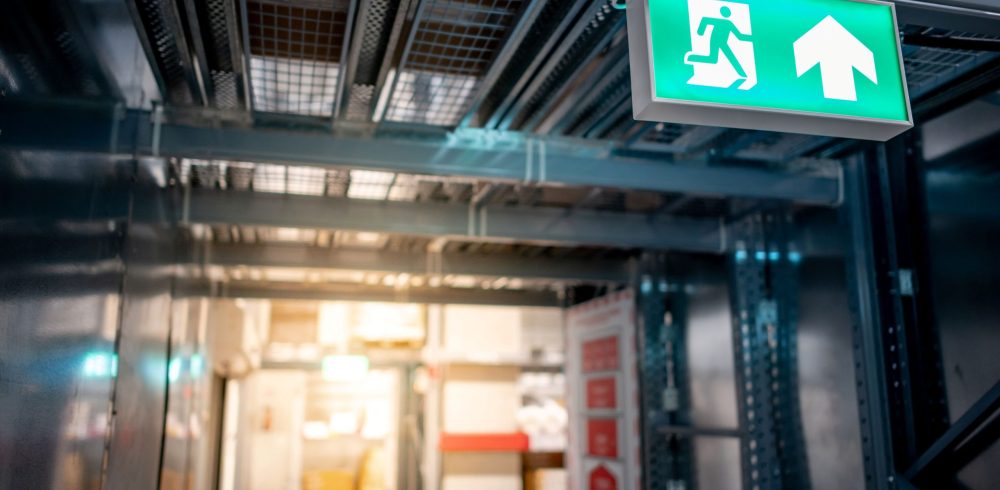From schools and shops to flats and factories, emergency lighting is an important component in safe building evacuations. Failure to keep lighting systems in working order not only puts businesses at risk of large fines but endangers lives too. Here, Andrew Keith, division director of load bank manufacturer Power Prove, explains how load bank testing can ensure emergency lighting is reliable in the moment of need.
The UK saw 241 fatal fires during the twelve months ending in September 2024, making thorough safety precautions essential for building owners and facilities managers. During fires and other building evacuations, emergency lighting helps to guide occupants safely towards exits by illuminating stairwells and hazard areas in smoke-filled or dark environments.
Given the importance of emergency lighting in safeguarding lives, building owners have a legal obligation to maintain it effectively. The Regulatory Reform (Fire Safety) Order 2005 states that emergency routes and exits requiring illumination must be fitted with lighting of adequate intensity that functions in the event of normal lighting failure. There are also standards in place, such as BS 5266 and BS EN 50172:2024, to provide the testing and maintenance framework for these systems.
Failing to meet these requirements compromises safety and may also lead to prosecution. In one notable case from 2020, a care home operator was fined £400,000 for fire safety failings, which included inadequate emergency lighting provisions.
So, how can building owners remain compliant and keep occupants safe in the case of emergency?
Assured power
Emergency lighting systems can be divided into two categories: maintained and non-maintained. Maintained lighting is typically used in dark environments where emergency signs need to be lit at all times, such as theatres and cinemas. Maintained systems normally operate using mains power, only switching to battery-powered output during a power cut.
By contrast, non-maintained lighting is designed to turn on automatically in the event mains power fails and should be able to remain operational for three hours. Both setups depend on batteries that must perform under pressure, whether that be a central battery system or smaller batteries located within each fitting.
Central battery systems, which distribute power to each emergency light fitting, may also be responsible for other safety fixtures such as automatic fire extinguishers or smoke extraction equipment. Therefore, it’s vital that building managers can verify the reliability of these battery systems.
BS 5266-1:2016 states that centrally supplied systems should use batteries with a declared life expectancy of at least ten years at 20°C ambient temperature. For low power supply systems, which have a limited power output of 500 watts (W) for three hours or 1,500 W for one hour, the batteries used should have a declared life expectancy of at least five years at 20°C ambient temperature.
Proving battery performance
For these systems, the most effective way to ensure they will work when needed is through battery discharge testing with a load bank.
Although static checks such as no-load voltage or impedance readings offer building owners an insight into battery condition, they don’t always give the full picture. Discharge testing using a load bank is preferable for verifying emergency lighting reliability. By simulating real-world operating conditions, discharge testing reveals how a battery performs when needed, providing clear evidence of whether it meets the legal requirements for central power systems.
It is recommended that battery discharge testing be carried out every six to twelve months to ensure greater reliability. However, discharge tests are also useful where full maintenance records may be lacking, or where batteries are nearing the end of their stated lifespan. A simple offline discharge test can be carried out easily, providing building owners and facility managers with unambiguous results to inform repair or replacement decisions.
Power Prove has extensive experience in providing portable DC load banks for on-site load testing of battery systems at voltages of up to 1000V DC and continuous power dissipation of up to 30 kilowatts (kW) in the standard range, with custom designs also an option.
When lives depend on battery-backed emergency systems, proactive testing with a load bank is a small step that delivers lasting peace of mind.
Looking for assurance that your emergency power system is fit for purpose? Get in touch with our expert team to learn more about the benefits of battery discharge testing.
Manufacturing & Engineering Magazine | The Home of Manufacturing Industry News















